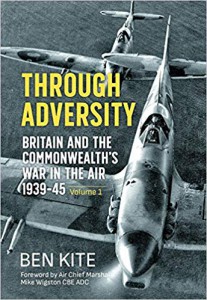It is unique to see how, every now and then, some people do manage to write a totally new refreshing book about WO II, from just a different view. Ben Kite is one of them! Thousands of books have been written about the activities by the British and their allies in the air. Ben Kite puts his focus on the battlefield in the air in the whole word, from Great Britain and the Commonwealth against the Axis alliance. The book ‘Through Adversity’ contains 508 pages and is printed on good paper, which makes that you also really feel that you have a proper book in your hands.
The book contains 25 chapters, magnificent card material and informative appendixes. De chapters are divided into 4 parts, being: Part I, contains a global overview about the build-up of the air force and the way in which pilots learned to fly; Part II is about keeping the supremacy in the air. Part III about the attacks and Part IV has some chapters about the air war from sea. In the parts II and IV you will find also a conclusion of the author about the preceding chapters with regard to best practises. The chapters set out the air war above and around Great Britain, but also in the Mediterranean Sea and the Far East. This gives the reader a broad view about all what has happened in those years in the world; and that was a lot!
Not only tells the book about the RAF, but also about the RAAF, RNAF, RCAF, SAAF, FAA and crew from different counties. The chapters in the book contain a lot of details. It sets out about tactics, historical facts, contexts, techniques and technology of that time. The facts are alternated with personal reports. Therefore it is, for example, interesting to read why Malta became of strategic importance to the British and the enemy and how the airports over there were defended against the planes of the Germans and Italians, who flew from Sicily. Pilot Officer Sugden – who flew a Hurricane- describes how they made appointments with Fighter Control to be better and more timely scrambled to so be able to catch the planes of the enemy. The radar was of crucial importance! The enemy also knew this and therefore they tried to fly below the radar.
A beautiful report of Tom Neil in in the book, who describes how such an attack by the enemy went, from low height…sirens…uncertainty…silence…doubt…all at once the air full with screaming plane engines..bombs…fire…explosions….finding cover.. It must have been enormous exciting and scaring times
And so there are all kinds of interesting chapters about, for example, how the supremacy in the air in the Far East was lost, in favour of the Japanese, the hunt on submarines, hazards of the Germans night hunters which could approach and shot the bombers about Western Europe from below/behind; and so on. Really too much to mention all here. All chapters have quotes and good black and white pictures (155 in total)
What finishes the book are the 14 colour cards. This gives a more orderly view of who, what and where, throughout the years. Interesting are also the 25 appendixes. These contain countless numbers and overviews, from planes, from the allied and Germans, Italian and Japanese available per year and their performances, till the checklist of the Spitfire, of codenames (Kipper, Rodeo, Rover, etc.), till numbers of trained pilots. Did you know for example that, in the end, more than a million people worked at the RAF and WAAF in September 1945? Did you know that there were 333 Flying Training School worldwide? And so it continues with these kind of numbers.
Ben Kite has delivered a valuable and beautiful book with this Volume I. I am looking forward to Volume II.











Leave a Reply